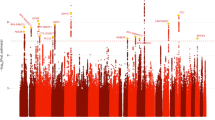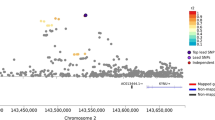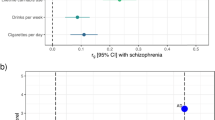Abstract
Genome-wide studies of psychiatric conditions frequently fail to explain a substantial proportion of variance, and replication of individual SNP effects is rare. We demonstrate a selective scoring approach, in which variants from several genes known to directly affect the dopamine system are considered concurrently to explain individual differences in cocaine dependence symptoms. 273 SNPs from eight dopamine-related genes were tested for association with cocaine dependence symptoms in an initial training sample. We identified a four-SNP score that accounted for 0.55% of the variance in a separate testing sample (p = 0.037). These findings suggest that (1) limiting investigated SNPs to those located in genes of theoretical importance improves the chances of identifying replicable effects by reducing statistical penalties for multiple testing, and (2) considering top-associated SNPs in the aggregate can reveal replicable effects that are too small to be identified at the level of individual SNPs.

Similar content being viewed by others
References
Achenbach TM, Krukowski RA, Dumenci L, Ivanova MY (2005) Assessment of adult psychopathology: meta-analyses and implications of cross-informant correlations. Psychol Bull 131:361–382
Amin N, van Dujin CM, Janssens ACJW (2009) Genetic scoring analysis: a way forward in genome wide association studies? Eur J Epidemiol 24:585–587
Begleiter H, Reich T, Hesselbrock V, Porjesz B, Li T-K, Schuckit M, Edenberg H, Rice J (1995) The collaborative study on the genetics of alcoholism. Alcohol Health Res World 19:228–236
Beuming T, Kniazeff J, Bergmann M et al (2008) The binding sites for cocaine and dopamine in the dopamine transporter overlap. Nat Neurosci 11:780–789
Bierut LJ (2007) Genetic variation that contributes to nicotine dependence. Pharmacogenomics 8:881–883
Bierut LJ, Strickland JR, Thompson JR, Afful SE, Cottler LB (2008) Drug use and dependence in cocaine dependent subjects, community-based individuals, and their siblings. Drug Alcohol Depend 95:14–22
Bierut LJ, Agrawal A, Bucholz KK et al (2010) A genome wide association study of alcohol dependence. Proc Natl Acad Sci USA 107:5082–5087
Bloch PJ, Nall AH, Weller AE, Ferraro TN, Berrettini WH, Kamman KM, Pettinati HM, Dackis CA, O’Brien CP, Oslin DW, Lohoff FW (2009) Association analysis between polymorphisms in the dopamine D3 receptor (DRD3) gene and cocaine dependence. Psychiatr Genet 19:275–276
Blum K, Braverman ER, Holder JM, Lubar JF, Monastra VJ, Miller D, Lubar JO, Chen TJ, Coming DE (2000) Reward deficiency syndrome: a biogenetic model for the diagnosis and treatment of impulsive, addictive, and compulsive behaviors. J Psychoact Drugs 32:1–112
Briand LA, Flagel SB, Garcia-Fuster MJ et al (2008) Persistent alterations in cognitive function and prefrontal dopamine D2 receptors following extended, but not limited, access to self-administered cocaine. Neuropsychopharmacology 33:2969–2980
Bucholz KK, Cadoret R, Cloninger CR et al (1994) A new, semi-structured psychiatric interview for use in genetic linkage studies: a report on the reliability of the SSAGA. J Study Alcohol 55:149–158
Buckland PR (2008) Will we ever find the genes for addiction? Addiction 103:1768–1776
Caine SB, Thomsen M, Gabriel KI et al (2007) Lack of self-administration of cocaine in dopamine D1 receptor knock-out mice. J Neurosci 27:13140–13150
Chen K, Kandel D (2002) Relationship between extent of cocaine use and dependence among adolescents and adults in the United States. Drug Alcohol Depend 68:65–85
Dackis CA, Gold MS (1985) New concepts in cocaine addiction: the dopamine depletion hypothesis. Neurosci Biobehav Rev 9:469–477
Derauf C, Kekatpure M, Neyzi N, Lester B, Kosofsky B (2009) Neuroimaging of children following prenatal drug exposure. Semin Cell Dev Biol 20:441–454
Derringer J, Krueger RF, Dick DM et al (2010) Predicting sensation seeking from dopamine genes: a candidate system approach. Psychol Sci 21:1282–1290
Evans DM, Visscher PM, Wray NR (2009) Harnessing the information contained within genome-wide association studies to improve individual prediction of complex disease risk. Hum Mol Genet 18:3525–3531
Fernàndez-Castillo N, Ribasés M, Roncero C, Casas M, Gonzalvo B, Cormand B (2010) Association study between the DAT1, DBH and DRD2 genes and cocaine dependence in a Spanish sample. Psychiatr Genet 20:317–320
Ford JD, Gelernter J, DeVoe JS et al (2009) Association of psychiatric and substance use disorder comorbidity with cocaine dependence severity and treatment utilization in cocaine-dependent individuals. Drug Alcohol Depend 99:193–203
Ge D, Goldstein DB (2007) WGAViewer: package of whole genome association annotation. Version 1.10. Durham, NC
Gillespie N, Neale M, Prescott C, Aggen S, Kendler K (2007) Factor and item-response analysis DSM-IV criteria for abuse of and dependence on cannabis, cocaine, hallucinogens, sedatives, stimulants and opioids. Addiction 102:920–930
Giros B, Jaber M, Jones SR, Wightman RM, Caron MG (1996) Hyperlocomotion and indifference to cocaine and amphetamine in mice lacking the dopamine transporter. Nature 379:606–612
Goldman D, Oroszi G, Ducci F (2005) The genetics of addictions: uncovering the genes. Nat Rev Genet 6:521–532
Gray JD (1993) Medical consequences of cocaine. Can Fam Physician 39(1975–1976):1979–1981
Haile CN, Kosten TR, Kosten TA (2007) Genetics of dopamine and its contribution to cocaine addiction. Behav Genet 37:119–145
Harford TC, Yi HY, Faden VB, Chen CM (2009) The dimensionality of DSM-IV alcohol used disorders among adolescent and adult drinkers and symptom patterns by age, gender, and race/ethnicity. Alcohol Clin Exp Res 33:868–878
Henry DJ, White FJ (1991) Repeated cocaine administration causes persistent enhancement of D1 dopamine receptor sensitivity within the rat nucleus accumbens. J Pharmacol Exp Ther 258:882–890
Herzberg I, Valencia-Duarte AV, Kay VA, White DJ, Müller H, Rivas IC, Mesa SC, Cuartas M, Garcia J, Bedova G, Cornejo W, Ruiz-Linares A, Kremeyer B (2010) Association of DRD2 variants and Gilles de la Tourette syndrome in a family-based sample from a South American population isolate. Psychiatr Genet 20:179–183
Hesselbrock M, Easton C, Bucholz KK, Schuckit M, Hesselbrock V (1999) A validity study of the SSAGA—a comparison with the SCAN. Addiction 94:1361–1370
Hill WG, Goddard ME, Visscher PM (2008) Data and theory point to mainly additive genetic variance for complex traits. PloS Genet 4:e1000008
Hnasko TS, Sotak BN, Palmiter RD (2007) Cocaine-conditioned place preference by dopamine-deficient mice is mediated by serotonin. J Neurosci 27:12484–12488
Johnson AD, Handsaker RE, Pulit S, Nizzari MM, O’Donnell CJ, de Bakker PIW (2008) SNAP: a web-based tool for identification and annotation of proxy SNPs using HapMap. Bioinformatics 24:2938–2939
Kendler KS, Prescott CA (1998) Cocaine use, abuse and dependence in a population-based sample of female twins. Br J Psychiatry 173:345–350
Kendler KS, Karkowski LM, Neale MC, Prescott CA (2000) Illicit psychoactive substance use, heavy use, abuse, and dependence in a US population-based sample of male twins. Arch Gen Psychiatry 57:261–269
Kuhar MJ, Ritz MC, Boja JW (1991) The dopamine hypothesis of the reinforcing properties of cocaine. Trends Neurosci 14:299–302
Lai IC, Mo GH, Chen ML, Wang YC, Chen JY, Liao DL, Bai YM, Lin CC, Chen TT, Liou YJ (2011) Analysis of genetic variations in the dopamine D1 receptor (DRD1) gene and antipsychotic-induced tardive dyskinesia in schizophrenia. Eur J Clin Pharmacol 67:383–388
Laurie CC, Doheny KF, Mirel DB et al (2010) Quality control and quality assurance in genotypic data for genome-wide association studies. Genet Epidemiol 34(6):591–602
Levran O, Londono D, O’Hara K, Randesi M, Rotrosen J, Casadonte P, Linzy S, Ott J, Adelson M, Kreek MJ (2009) Heroin addiction in African Americans: a hypothesis-driven association study. Genes Brain Behav 8:531–540
Liu QS, Pu L, Poo MM (2005) Repeated cocaine exposure in vivo facilitates LTP induction in midbrain dopamine neurons. Nature 437:1027–1031
Munafò MR, Matheson IJ, Flint J (2007) Association of the DRD2 gene Taq1A polymorphism and alcoholism: a meta-analysis of case-control studies and evidence of publication bias. Mol Psychiatry 12:454–461
Munafò MR, Yalcin B, Willis-Owen SA, Flint J (2008) Association of the dopamine D4 Receptor (DRD4) gene and approach-related personality traits: meta-analysis and new data. Biol Psychiatry 63:197–206
Munafò MR, Timpson NJ, David SP, Ebrahim S, Lawlow DA (2009) Association of the DRD2 gene Taq1A polymorphism and smoking behavior: a meta-analysis and new data. Nicotine Tob Res 11:64–76
Nemoda Z, Lyons-Ruth K, Szekely A, Bertha E, Faludi G, Sasvari-Szekely M (2010) Association between dopaminergic polymorphisms and borderline personality traits among at-risk adults and psychiatric inpatients. Behav Brain Funct 6:4
Nichol PE, Krueger RF, Iacono WG (2007) Investigating gender differences in alcohol problems: a latent trait modeling approach. Alcohol Clin Exp Res 31:783–794
Nutt D, King LA, Saulsbury W, Blakemore C (2007) Development of a rational scale to assess the harm of drugs of potential misuse. Lancet 369:1047–1053
Plomin R, Haowrth CM, Davis OS (2009) Common disorders are quantitative traits. Nat Rev Genet 10:872–878
Price AL, Patterson NJ, Plenge RM, Weinblatt ME, Shadick Nam Reich D (2006) Principal components analysis corrects for stratification in genome-wide association studies. Nat Genet 38:904–909
Purcell SM, Wray NR, Stone JL, Visscher PM, O’Donovan MC, Sullivan PF, Sklar P, International Schizophrenia Consortium (2009) Common polygenic variation contributes to risk of schizophrenia and bipolar disorder. Nature 460:748–752
R Development Core Team (2009) R: a language and environment for statistical computing. Version 2.10.1. R foundation for statistical computing. Vienna, Austria. http://www.R-project.org
Robinson JD, Lam CY, Minnix JA, Wetter DW, Tomlinson GE, Minna JD, Chen TT, Cinciripini PM (2007) The DRD2 TaqI-B polymorphism and its relationship to smoking abstinence and withdrawal symptoms. Pharmacogenomics J 7:266–274
Rocha BA, Fumagalli F, Gainetdinov RR et al (1998) Cocaine self-administration in dopamine-transporter knockout mice. Nat Neurosci 1:132–137
Self DW, Barnhart WJ, Lehman DA, Nestler EJ (1996) Opposite modulation of cocaine-seeking behavior by D1- and D2-like dopamine receptor agonists. Science 271:1586–1589
Shaffer HJ, Eber GB (2002) Temporal progression of cocaine dependence symptoms in the US National Comorbidity Survey. Addiction 97:543–554
Sora I, Wichems C, Takahashi N et al (1998) Cocaine reward models: conditioned place preference can be established in dopamine- and in serotonin-transporter knockout mice. Proc Natl Acad Sci USA 95:7699–7704
Substance abuse and mental health services administration (SAMHSA) (2009) Results from the 2008 National Survey on Drug Use and Health: National Findings. NSDUH Series H-36. Office of spplied studies. Rockville, MD. www.samhsa.gov/
Thanos PK, Michaelides M, Benveniste H, Wang GJ, Volkow ND (2008) The effects of cocaine on regional brain glucose metabolism is attenuated in dopamine transporter knockout mice. Synapse 62:319–324
Ungless MA, Whistler JL, Malenka RC, Bonci A (2001) Single cocaine exposure in vivo induces long-term potentiation in dopamine neurons. Nature 411:583–587
van den Bree MB, Johnson EO, Neale MC, Pickens RW (1998) Genetic and environmental influences on drug use and abuse/dependence in male and female twins. Drug Alcohol Depend 52:231–241
Volkow ND, Wang GJ, Fischman MW et al (1997) Relationship between subjective effects of cocaine and dopamine transporter occupancy. Nature 386:827–830
Vukcevic D, Hechter E, Spencer C, Donnelly P (2011) Disease model distortion in association studies. Genet Epidemiol 35:278–290
Xu M, Hu XT, Cooper DC et al (1994) Elimination of cocaine-induced hyperactivity and dopamine-mediated neurophysiological effects in dopamine D1 receptor mutant mice. Cell 79:945–955
Zuk O, Hechter E, Sunyaev SR, Lander ES (2012) The mystery of missing heritability: genetic interactions create phantom heritability. Proc Natl Acad Sci USA 109(4):1193–1198
Acknowledgments
Financial Disclosures Drs. LJ Bierut, AM Goate, JR Rice, and S Saccone are listed as inventors on the patent “Markers for Addiction” (US 20070258898) covering the use of certain SNPs in determining the diagnosis, prognosis, and treatment of addiction. Dr. Bierut has acted as a consultant for Pfizer, Inc. in 2008. All other authors report no competing interests. Study of Addiction: Genetics and Environment (SAGE). Funding support for the Study of Addiction: Genetics and Environment (SAGE) was provided through the NIH Genes, Environment and Health Initiative [GEI] (U01 HG004422). SAGE is one of the GWAS funded as part of the Gene Environment Association Studies (GENEVA) under GEI. Assistance with phenotype harmonization and genotype cleaning, as well as with general study coordination, was provided by the GENEVA Coordinating Center (U01 HG004446). Assistance with data cleaning was provided by the National Center for Biotechnology Information. Support for collection of datasets and samples was provided by the Collaborative Study on the Genetics of Alcoholism (COGA; U10 AA008401), the Collaborative Genetic Study of Nicotine Dependence (COGEND; P01 CA089392), and the Family Study of Cocaine Dependence (FSCD; R01 DA013423). Funding support for genotyping, which was performed at the Johns Hopkins University Center for Inherited Disease Research, was provided by the NIH GEI (U01HG004438), the National Institute on Alcohol Abuse and Alcoholism, the National Institute on Drug Abuse, and the NIH contract “High throughput genotyping for studying the genetic contributions to human disease”(HHSN268200782096C). Dr. A Agrawal receives support from NIH DA23668. Dr. LJ Bierut receives support from NIH DA21237. Dr. J Derringer receives support from NIH DA029377 and GM081739. Dr. RA Grucza receives support from NIH AA017444 and DA026612. Dr. S Saccone receives support from NIH DA024722.
Author information
Authors and Affiliations
Consortia
Corresponding author
Additional information
Edited by Valerie Knopik
Electronic supplementary material
Below is the link to the electronic supplementary material.
Rights and permissions
About this article
Cite this article
Derringer, J., Krueger, R.F., Dick, D.M. et al. The Aggregate Effect of Dopamine Genes on Dependence Symptoms Among Cocaine Users: Cross-Validation of a Candidate System Scoring Approach. Behav Genet 42, 626–635 (2012). https://doi.org/10.1007/s10519-012-9531-4
Received:
Accepted:
Published:
Issue Date:
DOI: https://doi.org/10.1007/s10519-012-9531-4




